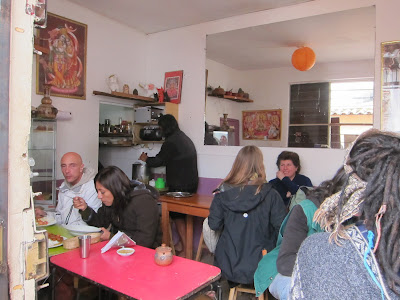What an adventure going to Cuzco! We planned everything in advance and had some good surprises. First we thought about going from Lima to Cuzco with a twenty-one hours overnight bus but we finally found a plane ticket for the same price. And the flight took us only one hour! Great find!


Arriving at Cuzco's airport we were harassed by at least thirty travel agency officers which presented themselves as information officials! Well we have read a lot about the tourist capital of Latin America and we tried to be less Gringos (ie walking ATMs) as possible. So we went back to asking the same question at least to three different people (hostels, tourism officers, people in the street, ...) to have a better idea about the correct answer. This way we managed to economize on taxi fares for example. From Cuzco's airport to the city center, we paid one third of what our hostel and some taxi drivers asked us, the only thing we had to do is to walk to the street in front of the airport to get a taxi.
Plaza de Armas by day...
... and by night
Cuzco was the administrative, political and military center of the largest empire in pre-Columbian America. Let's say it bluntly, we were somehow disappointed by Cuzco. The tourism-dominated city center is pretty and full of life. But to visit it fully, we were forced to buy two kinds of boletos: a boleto turístico to enter a handful of museums and some archeological sites in the Sacred Valley, and a boleto religioso to visit the three main churches of the city and a museum of religious art. Those tickets are very expensive for foreigners to visit sites in which photos are forbidden and not that good museums.
One of the many women in Andean clothes trying to have her picture taken in exchange for a tip
Museum of Contemporary Art
Maybe what we enjoyed the most in Cuzco was the clean and cheap tiny vegetarian restaurant, Govinda Lila’s, we found near San Blas Market. The charming lady running it seems to be a local figure hosting the starving local hippies.
Govinda Lila’s
Plaza San Blas
Most of all, Cuzco is the continent’s unquestionable archaeological capital. Our five days in Cuzco and its Sacred Valley were exhausting. It is all about waking up early to catch an early bus and hiking all day long among the remains of the Inca civilization. Worshipping the sun, the Incas built most of their temples and citadels very high or at the top of mountains. Beautiful landscapes and totally worth it!
Bus between Pisac and Urubamba
Sacred Valley
Well talking about an Inca civilization is incorrect as the Incas were only the successive leaders of an empire which expanded from the present-day Ecuador–Colombia border to the area south of Santiago in Chile. The glorious civilization left numerous ruins in the Andean highlands, the most famous of them being the Machu Picchu, presumably built as an estate for an Inca emperor. The site was abandonned at the time of the Spaniard conquest and rediscovered exactly one hundred years ago by the U.S. explorer Hiram Bingham, centennial commemorated by numerous official festivities.
Going to the Machu Picchu is not that easy. The site is located 110 kilometers away from Cuzco. The train from Cuzco to Aguas Calientes (the closest village to the Machu Picchu) is very expensive so most of us take one or various bus to Ollantaytambo, to catch there a train to Aguas Calientes (a one hour and a half train trip). Once in Aguas Calientes, a thirty-minutes bus climbs to the Machu Picchu site.
The sight is amazing especially viewed from top of the formerly cultivated terraces:

On the other side of the site the Huayna Picchu towers above the ruins of the Machu Picchu. It took us more than one hour to climb the Huayna Picchu, a very challenging hike!
Going down the Huayna Picchu
Machu Picchu site viewed from the Huayna Picchu
In the Sacred Valley, we also liked two sites. The various fortified structures on the heights of Pisac are amazing and offers a steep three hours walk from the higher stronghold to Pisac colonial village down in the valley.
Ollantaytambo was an ancient Inca resting place. The narrow cobbled streets of the village are dominated by two massive Inca ruins.




















The entire Eichenstrasse 57 (Hamburg) crew wish you both a Very Merry Christmas and All the Best for 2012.
ReplyDeleteBest wishes to you all from La Paz! Have a wonderful family Christmas around a copious table (I am sure of it;)!!
ReplyDelete